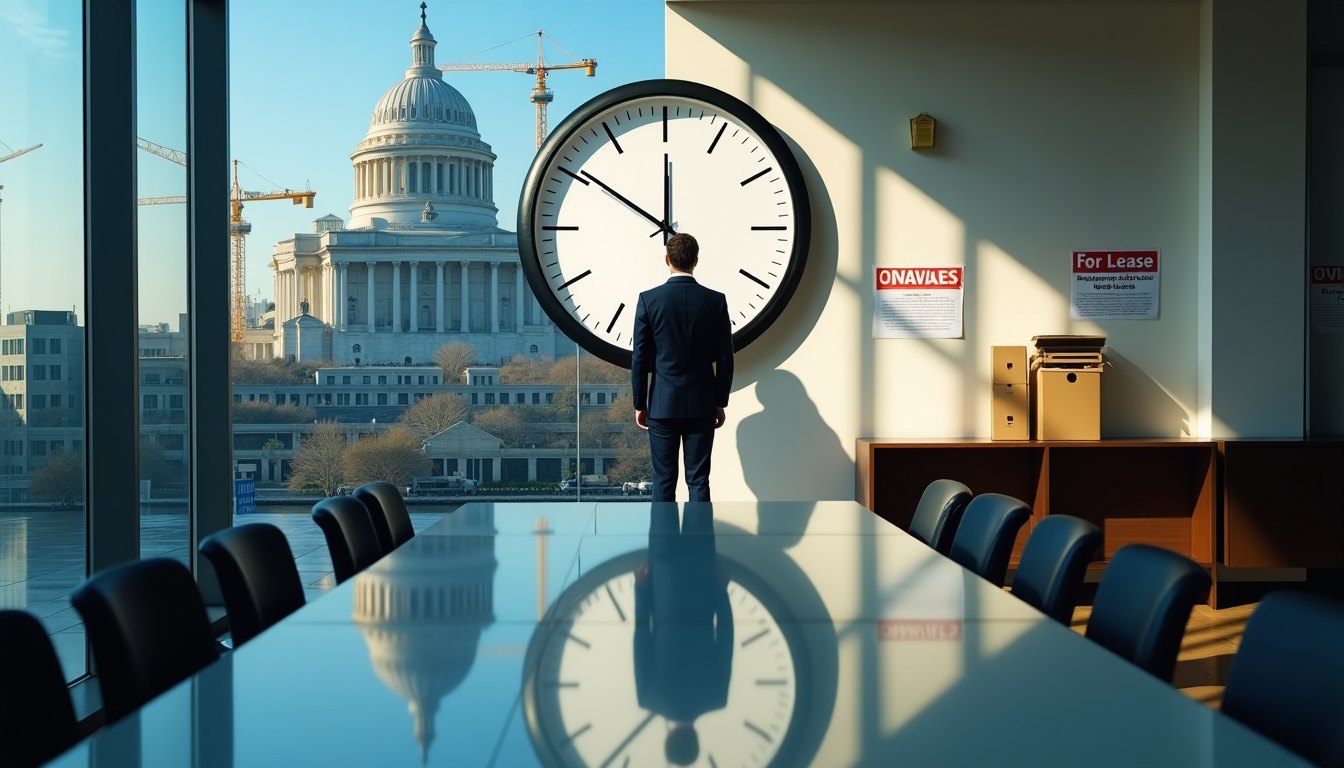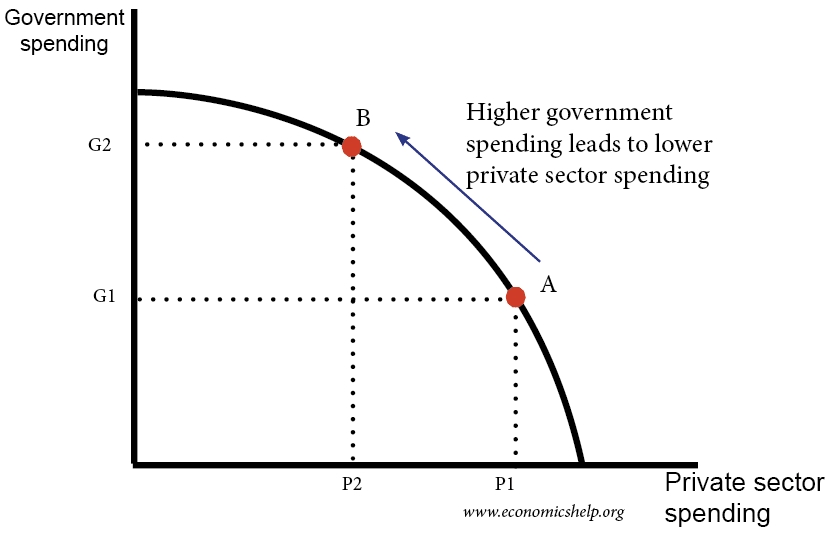Crowding Out Definition Explained: From Economic Theory to Real Market Impact

An additional $1 trillion in government debt could reduce GDP by 0.28% by 2050. This projection shows the major effect of the crowding out definition in modern economics. The private sector’s investment and economic activity decrease as government spending increases.
The crowding out effect shows up through higher interest rates and inflation. Private investors face more expensive borrowing costs. Government spending’s redirection of resources from private investment can reduce capital stock. This reduction hurts long-term economic growth in sectors from social welfare to infrastructure.
- Crowding Out Reduces Private Investment: Government borrowing raises interest rates and taxes, making it harder for private firms to invest.
- Economic Impact Is Long-Term: A $1 trillion rise in public spending could cut GDP by 0.28% by 2050 due to reduced capital formation.
- Three Main Channels: Interest rate hikes, lower private income from taxes, and resource competition, explain how crowding out occurs.
- Not All Spending Crowds Out: During recessions, public spending can “crowd in” private investment, especially when unused resources exist.
- Sector-Specific Effects: Infrastructure projects, welfare programs, and capital markets each experience unique forms of crowding out.
- Liquidity Traps Are Exceptions: In ultra-low interest environments, government spending may not raise rates, allowing full stimulus effect.
- Policy Design Matters: Smart, targeted public investments (such as in infrastructure or human capital) can reduce or reverse crowding-out effects.
What Is Crowding Out in Macroeconomics?
The crowding out definition describes what happens when government spending reduces or eliminates private sector investment and activity. This economic concept helps us understand how fiscal policy affects the economy in the long run.
The Basic Definition and Core Concept
Crowding out is a macroeconomic theory that shows how government intervention affects private sector spending through different channels. Money supply and demand drive this concept. Government borrowing or higher taxes to fund spending leave fewer funds available for private investment.
This economic principle shows up in several ways:
- Interest rates go up and make private borrowing more expensive
- Higher taxes leave people with less money to spend
- Limited economic resources create competition
Private businesses might abandon profitable projects because interest rates become too high. The Congressional Budget Office found that for every dollar increase in the federal deficit, private investment falls by approximately 33 cents.
Historical Development of the Crowding Out Theory
Economists have discussed crowding out ideas since the 18th century, though they didn’t use this term back then. The concept became popular in the 1970s and 1980s when free-market economists pushed back against public sector expansion.
Early debates focused on closed national economies with fixed savings. The rise of global capital markets in the 21st century changed these simple crowding out models completely.
Roger Bacon and Walter Eltis published “Too Few Producers” in the 1970s. They built on eighteenth-century ideas about “productive” versus “unproductive” labor. Their work showed Britain’s economy suffered from public sector growth. Financial crowding out theories emerged at the same time and explored how government borrowing raised interest rates.
When Government Spending Displaces Private Investment
Private investment gets displaced by government spending under specific conditions. Competition between government and private sector intensifies when the economy runs at full capacity. This shifts production patterns and cancels out stimulus benefits.
Economic downturns tell a different story. Government deficits don’t usually compete with private sector needs during these times. Stimulus programs work better and might even encourage more private spending.
The way government uses funds matters too. Unproductive spending can slow long-term growth by reducing capital formation. Smart investments in infrastructure and human capital might boost long-run growth by expanding productive capacity.
Capital markets feel the strongest crowding out effects. Economic models suggest that increasing government spending by $1 trillion could decrease output by 0.23% by 2031 and 0.28% by 2050.
How the Crowding Out Effect Actually Works

Image Source: Economics Help
The economy feels the squeeze of crowding out through three main channels that reduce private sector activity in different ways. These channels help us understand how government spending decisions affect the broader economy.
The Interest Rate Channel: Higher Rates, Less Investment
Government borrowing directly affects interest rates in financial markets. A Congressional Budget Office study revealed that each percentage point increase in the debt-to-GDP ratio pushes inflation-adjusted 10-year interest rates up by 2-3 basis points. This small increase adds up substantially as government debt grows.
Rising interest rates make borrowing costlier throughout the economy and deter private investment in several ways:
- Previously profitable projects become financially unfeasible
- Businesses face higher capital costs
- Expected returns must be higher to justify new ventures
Each dollar increase in federal deficit leads to a 33-cent drop in private investment. This reduced capital formation ends up limiting long-term economic growth potential.
The Tax Revenue Channel: Reduced Private Income
Governments often raise taxes to fund increased spending, beyond just borrowing. Higher taxes cut into disposable income that could go toward private consumption and investment. Research shows tax hikes equal to 1% of GDP lead to an output drop of nearly 3% over three years.
More than that, tax policy changes shape business decisions substantially. Data shows a single percentage point rise in corporate tax rates makes companies 2.9% less likely to set up new business subsidiaries. These effects remain true even after considering other economic factors.
Resource Competition Between Public and Private Sectors
Competition for limited economic resources creates the third channel. The economy running near full capacity means government spending takes resources away from private uses – what economists call ‘real’ crowding out.
Research on loan markets shows that government spending increases relative to GDP by one percentage point drive loan spreads up by 8.5 basis points. This hits business borrowing costs regardless of central bank rates.
Economic conditions play a big role in how strong crowding out becomes. Recessions with unused resources tend to see weaker crowding out effects. But as the economy approaches full employment, competition for resources intensifies and crowding out hits harder across every channel.
Different Types of Crowding Out Effects
Different economic sectors demonstrate crowding out in unique ways. Economists now think about several specific forms that affect various parts of the economy beyond the basic concept.
Economic Crowding Out Through Capital Markets
Government borrowing reduces financial capital available to private investments. This creates economic crowding out. Studies reveal that a $100 billion increase in government spending can decrease output by 0.02 percent in 2031. This happens due to a 0.06 percent reduction in capital. The effect grows stronger over time. A $1 trillion government expenditure could reduce output by 0.23 percent in 2031 and 0.28 percent by 2050.
Market conditions play a big role in determining how severe economic crowding out becomes. Banks usually have savings to lend but few borrowers during recessions. This makes crowding out less noticeable. The effect becomes much worse when the economy runs near capacity because everyone competes for scarce resources.
Social Welfare Crowding Out
People might reduce their charitable giving when government welfare programs expand. This happens because many call their tax payments substitutes for voluntary donations. Higher taxes for welfare programs leave individuals and businesses with less money to give to charity.
Research tells an interesting story about this effect. Some studies show small but important crowding-out effects. Others find no effect or even evidence of “crowding in”. Policymakers see this as a hidden cost of public spending. The good news is that private philanthropy won’t disappear completely.
Infrastructure and Public Goods Crowding Out
Private enterprises often step back from launching projects similar to government-funded development initiatives. To name just one example, see how government-built roads discourage companies from developing toll roads.
Public infrastructure spending creates both challenges and opportunities for private investment. New highways can boost returns on private investment by improving access to markets. Yet financing these projects through borrowing might increase public capital while reducing investment in potentially more beneficial private physical capital.
Understanding these different types of crowding out helps us review the real economic effects of government policies in different sectors.
Crowding Out vs. Crowding In: The Ongoing Debate
Government spending usually reduces private investment through crowding out. However, research shows this isn’t always true. Economists still debate the relationship between public and private spending, which shapes major policy decisions.
Government Spending Boosts Private Investment
Traditional crowding out theory doesn’t tell the whole story. Sometimes government spending actually encourages private investment – economists call this “crowding in.” This happens because public spending makes cash flow more valuable, which helps companies get financing. Research shows that companies with limited financial options invest 10-13 cents more for every $1 of federal purchases over four quarters. Companies with easy access to money don’t show this effect.
Government spending creates jobs and boosts output directly instead of competing with private investment. This boost in income gets more and thus encourages more private spending. Studies show that companies invest more after getting government contracts. This proves government spending affects entire industries, which rules out complete crowding-out.
Economic Conditions That Drive These Effects
These factors determine if crowding out or crowding in wins out:
- Resource availability – Economies running below capacity see less crowding out because extra resources exist
- Financing constraints – Industries that need more external funding react more strongly to government spending
- Investment climate – Public investment lowers risk, making private investment more attractive
The private sector’s unused savings during recessions make crowding in more likely. The massive federal spending on bonds and securities during the 2007-2009 Great Recession actually lowered interest rates. This went against what crowding out theory predicted.
The Liquidity Trap Exception
A liquidity trap creates unique conditions where crowding out vanishes. The “Liquidity-Money” curve becomes flat, letting government spending work fully without changing interest rates. No investment gets cut off, and nothing holds back government spending.
People prefer holding cash instead of investing during a liquidity trap, which usually happens when interest rates are very low and savings are high. Public spending becomes one of the few tools left to stimulate the economy, whatever the deficit concerns might be.
Conclusion
Modern economic dynamics depend heavily on how crowding out works. This economic concept shows how government spending disrupts private investment through several channels.
Higher government spending can reduce private sector activity in multiple ways. Interest rates go up, taxes increase, and competition for resources intensifies. Economic conditions play a vital role in the outcome. Government spending might boost private investment through crowding in during recessions. Full-employment periods, however, tend to see stronger crowding-out effects.
Real-life examples show different ways crowding out affects economic sectors. Interest rate changes create measurable effects in capital markets. Social welfare programs’ effects on private charitable giving are more complex. On top of that, infrastructure spending creates opportunities and challenges for private investors.
Policymakers should weigh their public spending decisions carefully against what it all means for crowding out. These decisions shape long-term economic growth, private sector investment, and market efficiency. The value of understanding these relationships grows as economies evolve, helping everyone make better financial decisions.
